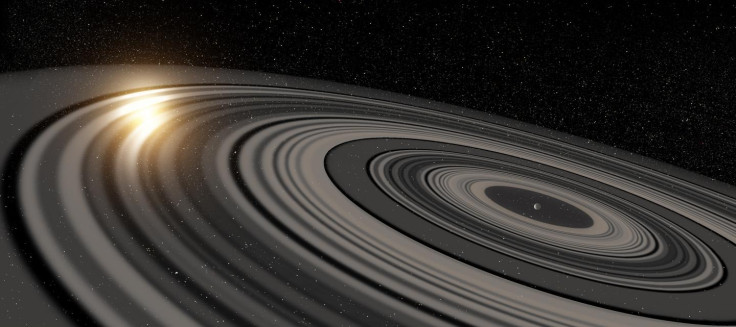Gigantic ring system 200 times larger than Saturn's around massive planet eclipsing parent star

A planet or brown dwarf with a mass around 10-40 times that of Jupiter and a ring system 200 times larger than Saturn's is believed to be eclipsing its young sun-like star J1407 in what is a first snapshot of satellite formation on million-kilometre scales.
The ring system around the giant companion planet consists of over 30 rings, each of them tens of millions of kilometres in diameter.
Astronomers from Leiden Observatory also found gaps in the rings, which indicate that satellites ("exomoons") may have formed in the region.
One such gap suggests the formation of a satellite the size of Earth.
The first of its kind to be discovered outside our solar system, the gigantic ring system was detected in 2012.
"The details that we see in the light curve are incredible. The eclipse lasted for several weeks, but you see rapid changes on time scales of tens of minutes as a result of fine structures in the rings," says Leiden's Matthew Kenworthy.
"The star is much too far away to observe the rings directly, but we could make a detailed model based on the rapid brightness variations in the star light passing through the ring system. If we could replace Saturn's rings with the rings around J1407b, they would be easily visible at night and be many times larger than the full moon."
"This planet is much larger than Jupiter or Saturn, and its ring system is roughly 200 times larger than Saturn's rings are today," said co-author Eric Mamajek, professor of physics and astronomy at the University of Rochester who first saw the ring system.
In 2012, Mamajek and colleagues proposed that the eclipse was caused by a moon-forming disk around a young giant planet or brown dwarf.
The astronomers analysed data from the SuperWASP project - a survey that is designed to detect gas giants that move in front of their parent star.
In a more recent study, also led by Kenworthy, adaptive optics and Doppler spectroscopy were used to estimate the mass of the ringed object. Their conclusion based on these and previous papers is that the companion is likely to be a giant planet - not yet seen - with a gigantic ring system responsible for the repeated dimming of J1407's light.
The diameter of the ring system is nearly 120 million kilometres, more than two hundred times as large as the rings of Saturn. The ring system likely contains roughly an Earth's worth of mass in light-obscuring dust particles.
The rings block as much as 95% of the light of the star for days, indicating the presence of abundant satellite forming material.
In the data, the astronomers found at least one clean gap in the ring structure, which is more clearly defined in the new model. "One obvious explanation is that a satellite formed and carved out this gap," says Kenworthy. "The mass of the satellite could be between that of Earth and Mars. The satellite would have an orbital period of approximately two years around J1407b."
Astronomers expect that the rings will become thinner in the next several million years and eventually disappear as satellites form from the material in the disks.
Astronomers estimate that the ringed companion J1407b has an orbital period roughly a decade in length. The mass of J1407b has been difficult to constrain, but it is most likely in the range of about 10 to 40 Jupiter masses.
Amateur astronomers are being called to help monitor J1407 to determine the period and mass of the ringed companion.
© Copyright IBTimes 2025. All rights reserved.





















